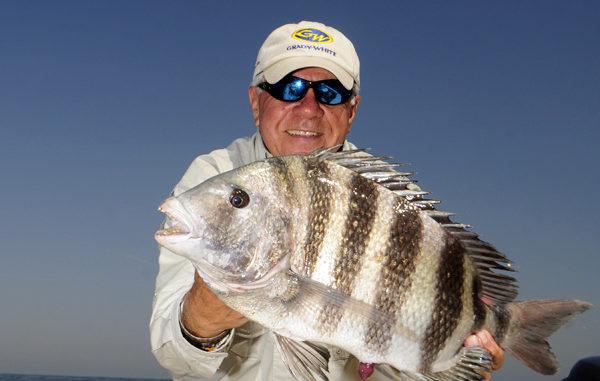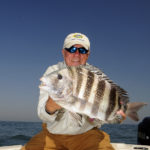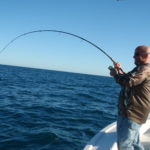
Reefs and wrecks outside of Bulls Bay provide great winter action for anglers targeting this tasty fish.
Diehard anglers willing to tough out February’s chilly breezes can face a commanding challenge from one of the most powerful fish of winter. Sheepshead, aka “convicts of the sea” for their striped outerwear, migrate from jagged inshore dwellings to reefs and wreck just a hop and skip outside the mouth of Bulls Bay. They arrive at these undersea retreats in massive schools to spend the winter, preparing for the early spring spawn. They become overly aggressive, contributing to the mind-blowing action that’s practically unknown to many South Carolina anglers.
Each fall, adult sheepshead vacate their inshore summer homes and travel out to sea in search of the nearest temperature-stable locations with adequate foods available to sustain them for the winter. When water temperatures dip below 50 degrees, most will have vacated inshore areas, ultimately finding deep-water spots with structure and the 60- to 70-degree water that’s ideal for spawning.
Capt. Jordan Pate of Carolina Guide Service (843-814-7900) has success catching winter sheepshead around the wrecks and artificial reefs not too far from shore.
“Wrecks, artificial reefs, and hardbottom areas will hold wintering sheepshead. We usually start at the nearshore places in 30 to 40 feet of water,” said Pate, who usually doesn’t have to travel more than 20 miles into the ocean from January through March. “Almost all of the reefs with good structure will hold winter sheeps, but we will hit some of the local wrecks and reefs including Cape Romain Reef, the Jimmy Leland Tug and the CCA McClellanville Reef out of Five Fathom Creek from the north side of Bulls Bay.”
On the southern end, Pate will fish Capers Reef and out to the Charleston 60 if needed.
The winter sheepshead fishery will quickly top summertime fishing because of the enormous schools and their aggressive winter feeding mechanism. Prespawn and spawning behavior energizes their appetites for energy-packed meals, leading to some crunching bites — unlike the subtle strikes of summer.
Sheepshead consume mainly crustaceans, including barnacles, mussels, small crabs and shrimp. While barnacles and other foods will be available in their winter homes, their staple summertime fare, fiddler crabs, will only be a memory. However, anglers with the proper resources can get sheepshead excited quickly with the proper offerings.
Capt. Robert McCarley of Reel Tight Fishing Charters (843-458-4157) anticipates a strong bite from winter sheepshead.
“They normally eat anything in front of them when in spawning mode and more aggressively,” he said. “We use clams, oysters, mussels and fiddler crabs to catch sheeps in winter.”
Not only will sheepshead feed more aggressively during the winter, the shear number of hungry fish out there will consume a bucket full of bait in little time. Even though sometimes tough to buy or catch in winter, China-back fiddler crabs are ideal baits. These small crabs bury deep into the mud flats in winter, and it’s tough to obtain enough for winter reef frenzies. Most bait shops will carry fiddlers, selling them by volume. McCarley will bring at least one pint of fiddlers per angler — plus a few extra pints.
“When you’re on a strong bite, the last thing you want is to run out of fiddlers,” he says.
Sheepshead will gobble up other baits without a second thought. Marsh mussels are an ideal alternative to fiddlers, and they are quite abundant inshore. They will attach to cord-grass (or Spartina) and along the undersides of floating docks, jetty rocks, and pilings. They are colonial and will bunch into clumps, connected by a type of filamentous algae. Anglers can collect these mussels by scraping them off their host structures with a putty knife or claw hammer.
Sheepshead are structure-oriented fish, and anglers must know where to soak baits around the reef site. While they will mingle around all sides of the structure, the snaggle-toothed beasts will not stray too far from the crusty, sunken architecture. Most reefs will have one or more buoys marking its location, but the actual location of the structure requires good sonar technology with GPS capabilities. Pate likes to set up very close to if not right on top of the irregularity, but sometimes the fish will associate to one side or the other.
“Ideally, I like to mark the edge of the structure with my depthfinder and anchor on lee side of structure. Fish like to congregate along this lee edge,” he said.
After getting the boat situated, anglers will know quickly if they area over fish or not. Sheepshead will be quite aggressive and will attach baits as soon as they arrive, but black sea bass and some other reef residents will steal anglers’ offerings before sheepshead get the chance.
“Don’t let the sea bass run you off from a spot. Keep the baits moving. Sheepshead will usually bite right after you lift off the bottom,” said Pate, who will fish around the boat for 20 to 30 minutes, weeding out the by-catch and determining if the boat is on the right spot. He will reset and repeat the process until he finds fish.
Sheepshead will stay on the bottom or suspend in the bottom quarter of the water column. Essentially, they will not stray too far from the structure, but they love shrimp — some small ones will be available around the reefs in winter.
While the traditional Carolina rig will catch sheepshead, McCarley and Pate prefer the drop-shot rig.
“It allows the angler to feel a bite the quickest, and that’s key to getting a good hookset,” McCarley said.
Pate rigs his drop-shot with a 2-way swivel. He attaches a 2-foot piece of 25-pound fluorocarbon leader with a 1- to 2-ounce teardrop sinker to one side of the swivel and a 6-inch piece of leader with a 1/0 to 2/0 straight-shank Owner hook. A sheepshead’s mouth is unusually hard, and an extremely sharp hook must be used to insure a good hookset. In addition, strong, braided line is recommended, especially when significant vertical structure is available. Seven-foot, medium-heavy rods and baitcasting reels are preferred.
Sheepshead are built for strength, offering lengthy battles to the boat. Anglers diagnosed with an extreme case of cabin fever should head out and latch on to one of these powerful ’beasts on the nearshore artificial reefs between Georgetown and Charleston. A bucket full of crustaceans and a short boat ride can reward willing anglers during typically the coldest month of the year.
DESTINATION INFORMATION
WHERE TO GO/HOW TO GET THERE — Prime spots out of Bulls Bay are easily accessible from the McClellanville municipal ramp off Jeremy Creek (annual or weekly fee is required) on the north end and the Buck Hall Recreational Area in the Francis Marion National Forest (daily use fee) near Awendaw on the south end of Bulls Bay. Both ramps are off US 17. Artificial reefs and wrecks in 30 to 40 feet of water will hold the majority of wintering sheepshead. Wrecks with the most vertical structure will usually produce best.
REEFS — On the northern end of Bulls Bay, the Hector Reef (Pa-20), the Jimmy Leland Tug (Pa-34) and the CCA McClellanaville Reef (Pa-34) are productive; from the southern end, Capers Reef (Pa-22) and the Charleston 60 (Pa-24) will hold large schools of sheepshead during the winter.
WHEN TO GO — Sheepshead schools move from inshore to the ocean when water temperatures drop below 60 degrees during winter and will continue through early spring when the spawning period begins. December through April is ideal at the nearshore reefs.
BAITS/TACKLE — China-back fiddler crabs and marsh mussels are the baits of choice for sheepshead. Chumming with crushed oysters and barnacles is very effective. Fish baits between the bottom and the lower quarter of the water column. Drop-shot rigs with 3-way swivels are commonly used with a long fluorocarbon leader tying on the sinker and a short piece of fluorocarbon leader tied to a 1/0 to 2/0 straight-shank Owner hook. Medium-heavy outfits are the norm.
GUIDES/FISHING INFO — Capt. Jordan Pate, Carolina Guide Service, 843-608-8307, http://www.carolinaguideservice.com/index/South_Carolina_Fishing_Charters.html; Capt. Robert McCarley, Reel Tight Fishing Charters, 843-458-4157, http://www.gofishsc.com/guide_services/Fishing_guides/robert_mccarley.htm.
ACCOMMODATIONS — Village Fish Camp, McClellanville, 843-814-7900, http://www.villagefishcamp.com/Village_Fish_Camp/Village_Fish_Camp.html; Charleston Area Convention & Visitors Bureau, http://www.charlestoncvb.com/; S.C. Association of Visitors Bureau, http://www.discoversouthcarolina.com/.
MAPS — Maps Unique, 910-458-9923, http://offshore-fishing-map.com/; Grease Chart, 800-326-3567; Sea Lake Fishing Guides, 800-411-0185, www.sealakeusa.com.







Be the first to comment